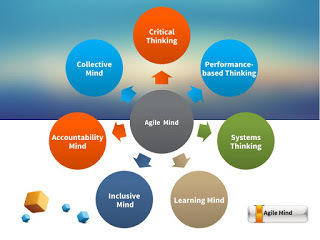“Digital Agility” Book Preview: Chapter 1: Agile is a State of Mind
 Almost every organization is using Agile now, however, the misunderstand idea is that people can ‘do’ Agile only. The truth is the “mechanical agile” will stop at certain point, the “doing Agile” will limit its value as technique practices only. Indeed, Agile is a state of mind. More as philosophy than methodology. Ultimately, you need to “be” Agile.
Almost every organization is using Agile now, however, the misunderstand idea is that people can ‘do’ Agile only. The truth is the “mechanical agile” will stop at certain point, the “doing Agile” will limit its value as technique practices only. Indeed, Agile is a state of mind. More as philosophy than methodology. Ultimately, you need to “be” Agile.
Dig through the “WHY”: To keep an agile mindset, you should put a high effort into making them productive within the context of a team environment. Without agile mindset, if team members are not able to resolve their conflicts, are they going to collaborate over problems? Often they might achieve individual goals, but collective team goals will not be achieved. With agile mindset, winning teams, not winning individuals create winning products. Such high mature teams will be in a very good state to decide which is the appropriate tool and process to respond to change quickly, and achieve business goals steadily. If not digging through the big “WHY,” the danger is when you start practicing because
The book said to do it this way,” or “because we have always been doing it that way.’ Practices need to be under scrutiny to see if those which were successful under yesterday’s context are still going to work out successfully in today’s context.
Advocate an integral approach to any transformation effort: Agile accelerates the flow, mind flow, information flow, knowledge flow and idea flow.,etc. It harnesses the development of human beings to move from hierarchical thinking to collaborative thinking. These altitudes of thought processes can be used to describe individuals, teams, programs, and organizations. Learn the agile principles, values, and mindset so that you can start becoming effective and making the best out of the ceremonies. Agile is like a journey you don’t know what challenges will come in your way. It’s unique so no one can prescribe it for you. Also, you can’t just take your team agile without engaging the rest of the organization. Because you can’t just take your team agile without engaging the rest of the organization. The progress to making agile transformation require more cooperation from the rest of the organization, given people across-functions a good argument for why you are doing it and what the benefits will be. The successful organization will be the one that understands the difference between a project schedule and an Agile roadmap, transforming to Agile means the business knows the direction they want to go on and people discover new ways of working, collaborating and delivering value, they inspect and adapt in that journey.
 Being customer-centric is a most important agile mentality shift: Agile mindset is about empathy, people-centricity, and improvement. Agile is not about free thinking or doing without structure, Agile doesn’t not take less discipline, but needs more engineering and management discipline. Being customer-centric means you have to adapt to the customer. It requires a customer approach that involves understanding the baseline, the desired state, the real business benefit, the what can you measure or qualify that would put you in the success and improve agility.
Being customer-centric is a most important agile mentality shift: Agile mindset is about empathy, people-centricity, and improvement. Agile is not about free thinking or doing without structure, Agile doesn’t not take less discipline, but needs more engineering and management discipline. Being customer-centric means you have to adapt to the customer. It requires a customer approach that involves understanding the baseline, the desired state, the real business benefit, the what can you measure or qualify that would put you in the success and improve agility. Agile is more a “direction,” than an “end.” Transforming to “being agile,” is a journey. It doesn't matter how much agile training you have had, the agile mind makes an effort and has a desire to continuously improve and be self-organizing and accountable, as people start “putting on” the agile mindset, discover new ways of working, collaborating, delivering value, they adapt in that journey be overcoming the frictions and achieve high-performing result.Follow us at: @Pearl_Zhu
Published on June 12, 2016 23:08
No comments have been added yet.



